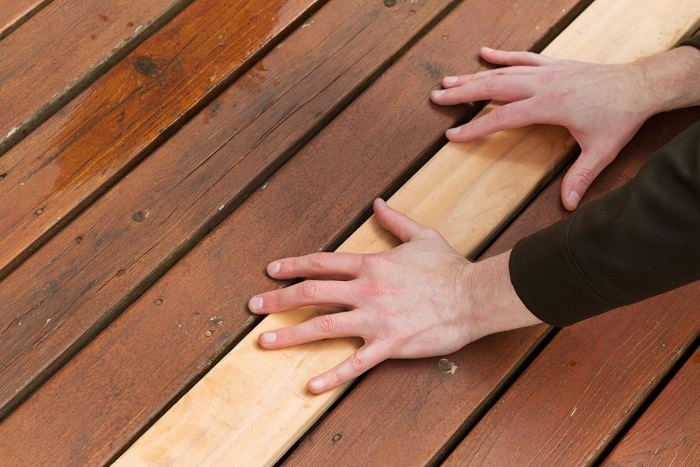
When you realize you need to replace your deck, you usually know right away. The finish on the decking materials’ surface begins to show signs of wear. Parts of the boards may be entirely rotten through or shattered in more challenging situations. In the worst-case scenario, the structure might begin to weaken, resulting in dangerous deck collapses.
If you require some TLC for your present deck, average repair prices can run into the hundreds of dollars. Depending on the decking materials you pick, the size of the deck, and local labour prices, a new deck can cost anywhere from hundreds to tens of thousands of dollars.
Whether you hire a contractor or construct the deck yourself, the average time it takes to finish a deck is roughly a week or less. If the repairs are modest, deck repair can be completed in as minor as a day. Contractor timetables, on the other hand, might differ.
We’ll go through the different types of decking materials and their benefits and drawbacks in the sections below. However, you must first determine if the deck should be repaired or replaced.
The first and foremost thing you should inspect is whether the frame itself is corrupted. Deck collapse can be caused by damage to the structural support. Corrosion can be visible in some circumstances, such as when you can see rot on the deck frame’s edge.
If you aren’t familiar with woodwork, you may need to hire a specialist to check it. They’ll look at things like guardrails and stair connections, which are more technical.
Decks with structural support but deteriorated boards and railings, on the other hand, can get away with an essential decking material replacement. All that’s left for you to do now is to replace the damaged boards and railings. Some decks may require light refinishing.
If you desire modern materials, keep in mind that they may be heavier. In such circumstances, the deck will require extra support. The expense of adding additional supports might be comparable to the cost of installing a new deck.
Another point to consider is that older decks produced before 2004 typically included the toxic chemical chromate copper arsenate, a form of timber preservative classified as a carcinogen due to the arsenic it contains. Fortunately, these sorts of decks may be refinished by a professional, which will seal the chemical away.
There are several decking materials available on the market, each with its own set of advantages and disadvantages. The most prevalent decking materials are listed here to help you determine which is best for you. They are:
This is constructed of natural wood that has been chemically treated to keep pests, fungi, and decay at bay. It’s inexpensive and straightforward to obtain. It can, however, crack, twist, and fracture with time. It also needs regular care, such as power cleaning once a year and restaining every few years.
People who value natural living and sustainability may wish to avoid decking materials that have been chemically treated. It is, nevertheless, the most affordable sort of decking material.
Natural woods are a terrific option for those who wish to avoid the toxins found in pressure-treated lumber. Redwood and red cedar, for example, have oils and tannins that make them inherently resistant to decay and insects. Tigerwood and ipe, for instance, are tropical hardwoods with similar resistance.
When looking for various kinds of decking materials, keep in mind that multiple varieties of wood are more durable than others. Natural lumber like redwood, like pressure-treated timber, require regular power cleaning and a fresh stain every few years. Different woods will require different levels of upkeep, so do your research. Prices vary widely depending on the grade and kind of wood.
PVC and polyethene, two popular materials, are commonly used to construct this sort of deck. Plastic timber is also available, which is entirely built of 100% recyclable plastic. Plastic is more long-lasting, particularly since it does not rot or deteriorate.
It’s also relatively light. However, this design moves away from the natural beauty of hardwood, which might be a disadvantage for those who prefer that look. It’s also slick and prone to sagging. Prices, like composites, are typically in the mid-range.
This decking material is made comprised of wood fibres and plastic. It’s a long-lasting choice that doesn’t warp, rot, or splinter like genuine wood. You don’t have to refinish it, but you may give it a new appearance with optional paint or stain.
However, because it appears more artificial, some individuals may not like the lack of natural texture and colour to avoid natural woods. It can also grow mould and degrade over time. When compared to other decking materials, you’ll be looking at a mid-range price.
Aluminium is one of the most durable decking materials available. It won’t decay, pests won’t eat it, it’s mould-resistant, won’t crack or warp, and the finishes will last a lifetime. However, as a disadvantage, it is the most expensive sort of decking. A metal deck’s clinical look may be unappealing to some.
As you can see, each decking style has its own set of advantages and disadvantages. As a result, the best decking for you will be determined by your budget, deck maintenance tolerance, backyard entertainment demands, and aesthetic preferences.
Remember that if the cost of fixing or improving an existing deck is comparable to the cost of installing a new one, you could be better off investing in a brand new deck that will last longer.
 Call Now
Call Now